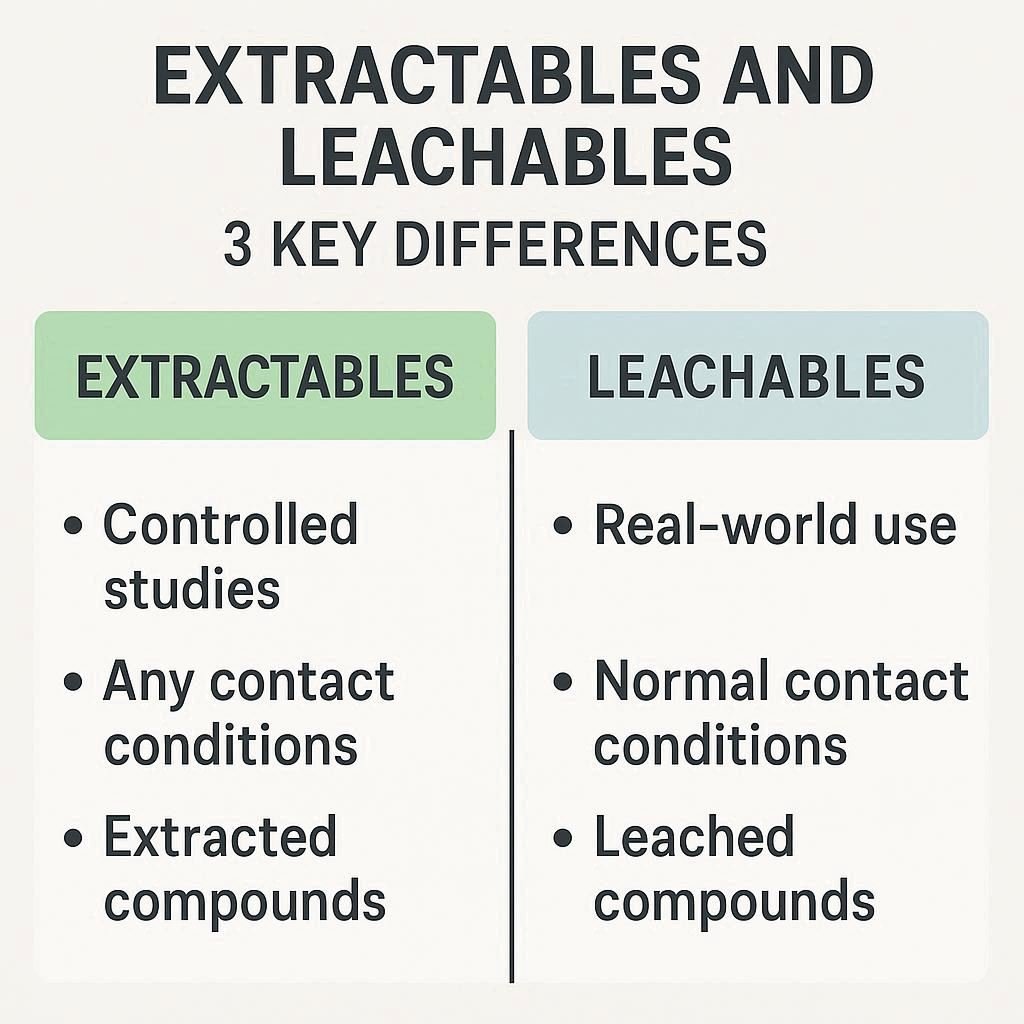Learn what extractables and leachables are, how they differ, and how they are tested in the pharmaceutical industry.
Extractables and Leachables (E&L) are critical in ensuring the safety, efficacy, and quality of pharmaceuticals by identifying potential contaminants.
Extractables are compounds released from materials under aggressive conditions (e.g., high heat or strong solvents), while leachables are substances that migrate into the final product under normal use and storage. Studying both is essential in pharmaceuticals and medical devices to ensure product safety and efficacy. Regulatory testing confirms that any migrating substances remain below harmful levels, protecting patient health.
Extractables are chemical compounds that can be drawn out (extracted) from packaging or device components when exposed to aggressive solvents under exaggerated conditions such as high temperature or extended time.
Purpose of Testing: Extractables studies are typically conducted early in development to identify all potential compounds that could migrate into the drug product.
Leachables are chemical compounds that actually migrate into the pharmaceutical product under normal storage, handling, and use conditions over time.
Purpose of Testing: Leachables are evaluated in the final drug product to assess real-world patient exposure and toxicological risk.
You may like:

| Feature | Extractables | Leachables |
|---|---|---|
| Definition | Compounds that can be extracted under forced conditions | Compounds that do migrate into the product under normal use |
| When Tested | Early development | Late-stage development and stability studies |
| Conditions | Aggressive (e.g., high temp, solvents) | Realistic (e.g., product formulation, storage) |
| Purpose | Risk identification | Risk confirmation and control |
| Sample Matrix | Packaging/device materials | Final drug product |
E&L studies are critical for:
E&L stands for Extractables and Leachables. In pharmaceuticals, it refers to the identification, quantification, and toxicological assessment of chemical substances that may migrate from container closure systems (CCS), packaging, or manufacturing components into the drug product.
This is critical to:
The FDA defines:
Both are considered potential impurities in drug products.
Examples include:
| Material Source | Example Compounds |
|---|---|
| Plasticizers from polymers | DEHP, DBP, phthalates |
| Antioxidants | BHT (Butylated hydroxytoluene), BHA |
| Lubricants | Stearates |
| Colorants | Aromatic amines, azo dyes |
| Manufacturing residues | Solvents, detergents |
| Elastomers (rubber stoppers) | 2-mercaptobenzothiazole, zinc stearate |
Major guidelines include:
| Guideline / Organization | Relevance |
|---|---|
| USP <1663> | Assessment of Extractables |
| USP <1664> | Assessment of Leachables |
| FDA Guidance | Container Closure Systems for Packaging Human Drugs and Biologics |
| ICH Q3E (New – under development) | Guideline on extractables and leachables |
| PQRI Recommendations (Parenteral and OINDP) | For inhalation and injectable drug products |
| EMA – European Medicines Agency | Requirements for packaging material and migration |
| ISO 10993 | For devices – biological evaluation |
Extractables are chemicals that are pulled out from packaging or processing materials using aggressive solvents and conditions (heat, time, solvent polarity). These are potential leachables but do not necessarily enter the drug product.
Leachables are chemicals that actually migrate into the pharmaceutical product during storage or use under normal conditions. These are considered real impurities and can affect product safety and efficacy.
E&L Testing involves:
Stages:
E&L testing is essential for:
| Risk Type | Example |
|---|---|
| Toxicity | Mutagenic, carcinogenic, or reproductive toxins |
| Product Quality | Reaction with API or excipients |
| Stability | Degradation of drug or packaging over time |
| Immunogenicity | Especially critical in biologics (e.g., proteins) |
| Regulatory Non-compliance | Product recall or delay in approval |
The need for ICH harmonisation in E&L arises because:
There is no single universal method, but a risk-based, case-specific approach is recommended.
However, standardized analytical workflows are emerging:
Measurement and analysis techniques for E&L include:
| Technique | Purpose |
|---|---|
| GC-MS | Volatile and semi-volatile organics |
| LC-MS | Non-volatile, polar organics |
| ICP-MS | Elemental impurities (e.g., metals) |
| FTIR | Material identification |
| NMR | Structural elucidation |
| UV-Vis | Quantitation of chromophores |
Extractables are potential migrants identified under harsh testing; leachables are actual migrants into the drug product. E&L testing is vital for drug safety, especially for parenterals, biologics, and inhalation products. Though methods vary, regulatory guidance is increasingly harmonized through organizations like ICH, FDA, EMA, and USP.
Further reading:
Related:
Extractable substances are compounds that can be pulled out of a material under aggressive, often non-physiological conditions (e.g., using strong solvents, heat).
Leachable substances are compounds that actually migrate from a material under normal use conditions (e.g., during storage or contact with a drug product).
Extractables in drug substances are chemical compounds that can be released from packaging, manufacturing components, or delivery systems when exposed to aggressive conditions.
Leachables are compounds that actually migrate into the drug product under normal storage or use conditions.
Quick Links